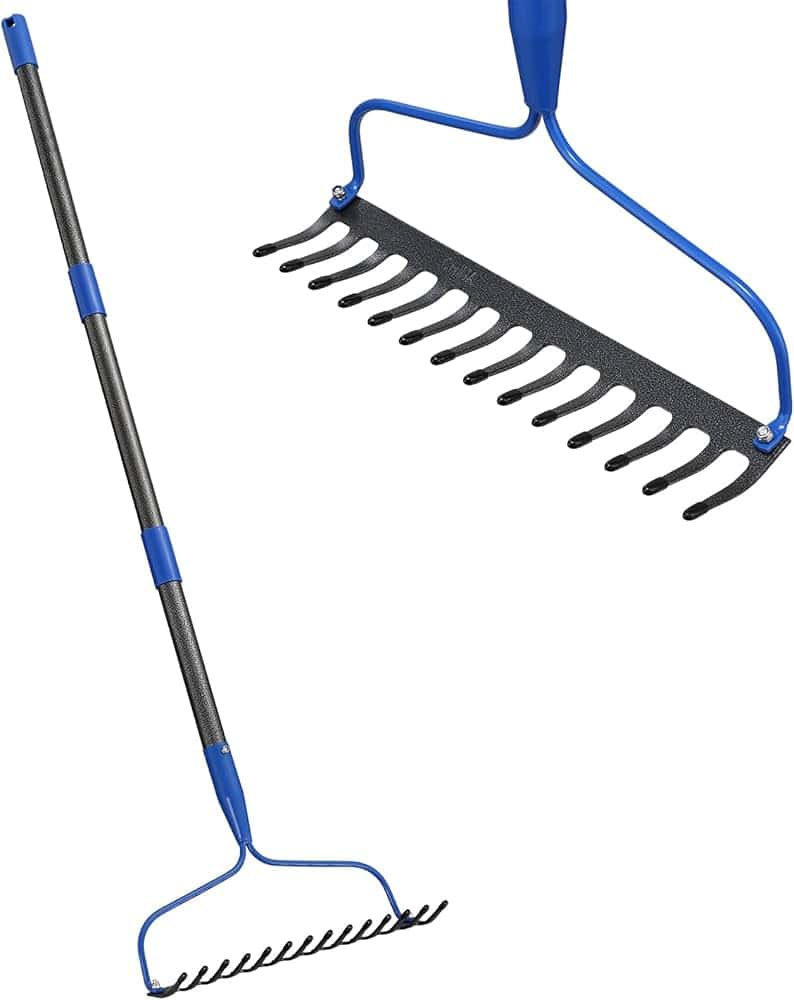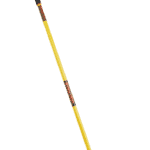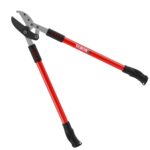The Bow Head Garden Rake is a powerful tool for anyone who loves to garden. It is mainly used for heavy-duty tasks like leveling soil, spreading mulch, and breaking up hard ground. Its metal tines are strong and can handle tougher jobs that other rakes can’t.
Gardeners appreciate this tool for its rigidity and durability. The Bow Head Garden Rake, sometimes called a level-head rake, is perfect for preparing garden beds. This rake is essential when removing weeds or rocks from soil.
Whether you are maintaining a lawn or creating a new garden bed, this rake is a must-have. It can make landscaping tasks easier and more efficient. The Bow Head Garden Rake is versatile and essential for any serious gardener’s toolkit.
Fundamentals of Bow Rakes
A bow rake is a versatile tool in gardening. It features a sturdy design and is ideal for heavy-duty tasks. It is built to last and serves various landscaping purposes effectively.
Design and Material
Design: A bow rake typically has a long handle, often measuring around 60 inches. This length helps reduce strain on the back by allowing the user to stand upright. The head of the rake is wide, and it features a series of short, rigid tines set at a 90-degree angle. These tines are spaced evenly to make sure the rake can move soil, gravel, or other materials smoothly.
Material: Bow rakes are commonly made from durable materials. Steel is widely used for the tines due to its strength and durability. The handle can be made of wood, aluminum, or fiberglass. Wooden handles can provide comfort and a classic feel, while aluminum and fiberglass handles are known for their lightweight and strength. A good bow rake has a comfortable grip to prevent blisters while working for long periods.
Optimal Use Cases
Bow rakes are designed for a variety of garden tasks. They excel in tough jobs like breaking up compacted soil, spreading mulch or gravel, and leveling soil for planting. The rigid tines can dig into the ground more effectively than a leaf rake, making it ideal for preparing garden beds.
This type of rake can also be used to remove weeds or dead grass from a lawn. It is particularly useful for landscaping projects where precise leveling and soil movement are required. The flat side of the head can be used to smooth out surfaces, making it a practical tool for garden and lawn maintenance.
Practical Applications in Gardening and Landscaping
A bow rake is essential for many gardening and landscaping tasks. It helps in preparing the soil, managing debris, and performing specialized gardening tasks.
Soil Preparation and Maintenance
The bow rake is perfect for preparing garden soil. It has a sturdy head with metal tines. These tines break up clumps of dirt and level the ground. This makes it easier for seeds to take root.
Gardeners also use bow rakes to spread mulch and compost. Mulch helps retain moisture in the soil and suppress weeds. Spreading compost enriches the soil with nutrients. The flat side of the rake can be used to smooth the soil after turning it over.
Debris and Leaf Management
Managing debris is another important use for the bow rake. While leaf rakes handle light yard debris, bow rakes are better for tougher jobs. They can move rocks, sticks, and other heavy items.
The bow rake’s sturdy tines are useful for gathering leaves into piles. This is helpful during fall when leaves cover the yard. The bow rake’s solid design ensures it can handle these tasks without bending or breaking.
Specialized Gardening Tasks
Bow rakes can also be used for more specific gardening projects. For example, they can help in the creation of garden beds. The rake’s sharp tines make it easy to outline and shape these beds.
Leveling and grading the soil are other tasks where the bow rake shines. This is important for new planting areas and landscaping projects. The rake ensures the ground is even, which is crucial for planting grass or other plants.
A bow rake is also handy for weed removal. The tines can pull out weeds from the roots. This helps keep the garden clean and free of unwanted plants. The rake can also help in spreading gravel or small stones for paths or borders.
In summary, the bow rake is a versatile and essential tool for various gardening and landscaping tasks. It helps prepare the soil, manage debris, and carry out specialized gardening projects.
Frequently Asked Questions
A bow rake is a vital tool in gardening for tasks like soil preparation, leveling, and debris collection. Here’s more specific information about its uses and features.
What are the primary uses of a bow rake in gardening?
A bow rake is mainly used to prepare the soil for planting. It can level the ground, remove weeds, and spread materials like compost or gravel. It’s a sturdy tool suitable for heavy-duty tasks.
How does a bow rake differ from a leaf rake in functionality?
A bow rake has rigid, metal tines that make it good for tough jobs like breaking up soil. A leaf rake, on the other hand, has flexible tines designed to collect light debris such as fallen leaves.
Can a bow rake be effectively used for collecting leaves?
Although not its primary use, a bow rake can collect leaves. It is better suited for heavier tasks, though, due to its stiff tines and strong build.
What are some professional tips for utilizing a rake in garden maintenance?
For best results, use a bow rake to spread mulch evenly over the soil. When removing weeds, press the rake down to reach the roots. Always keep the rake clean to prevent the spread of diseases.
What features should be considered when choosing the best bow rake?
When picking a bow rake, look for a sturdy handle and thick metal tines. A comfortable grip is also important, especially for long use. Durable materials like steel or aluminum can ensure longevity.
What are the distinguishing characteristics that define a bow rake?
A bow rake comes with a row of short, rigid tines attached to a metal frame called the bow. This frame makes the rake sturdy and gives it its name. The tines are usually 2-3 inches long, making the rake perfect for heavy-duty garden work.







